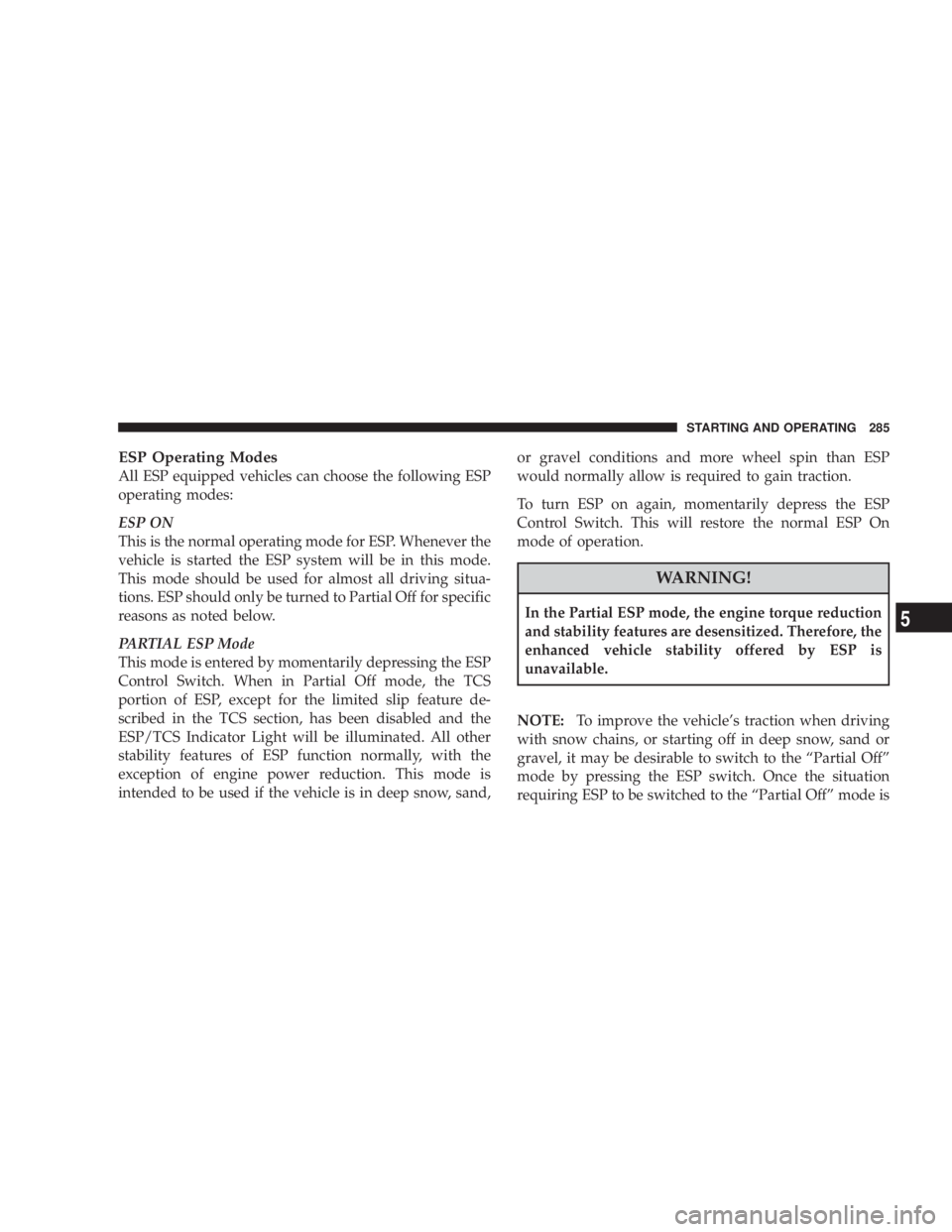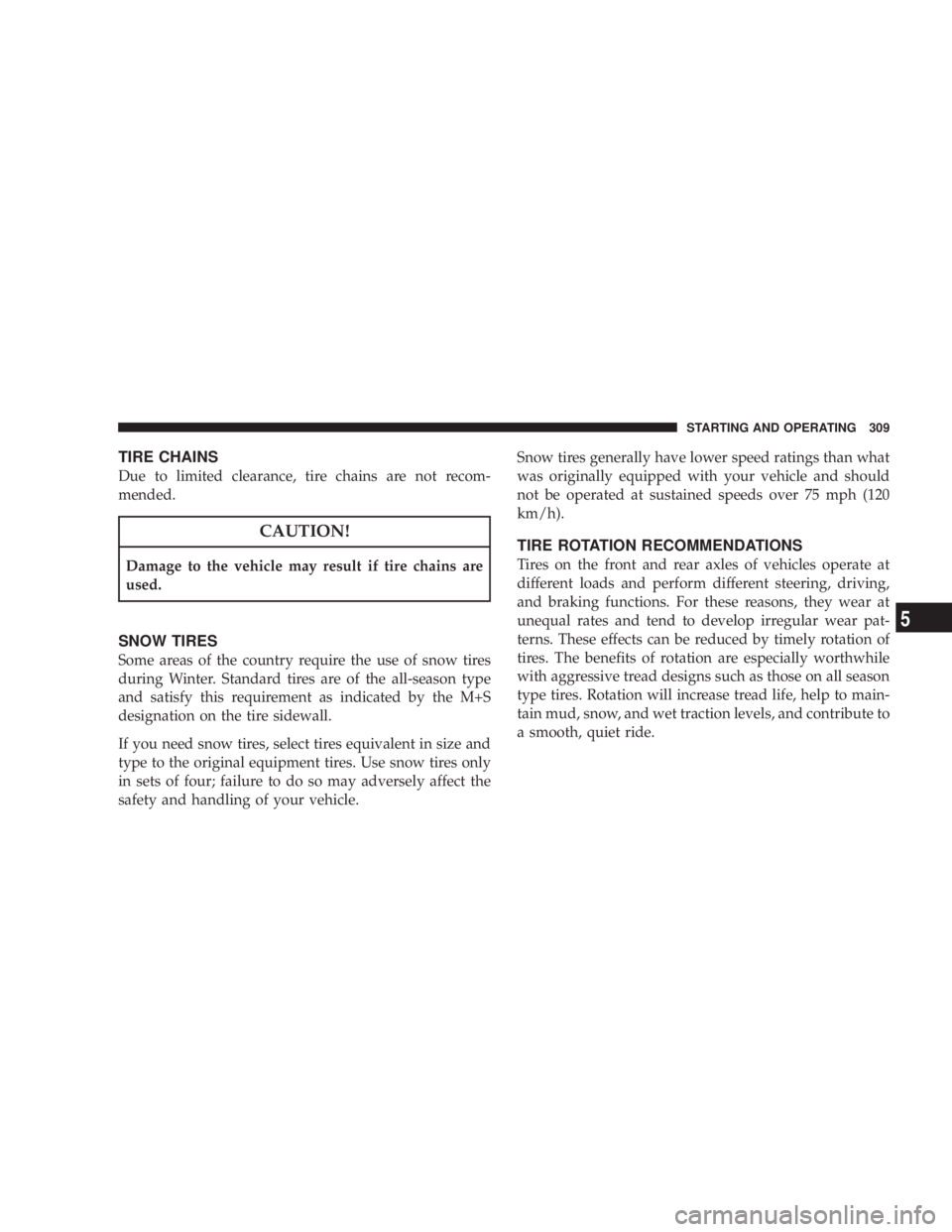2008 DODGE AVENGER snow chains
[x] Cancel search: snow chainsPage 261 of 467

N Tread Wear Indicators ..................306
N Life Of Tire .........................306
N Replacement Tires .....................307
N Alignment And Balance .................308
m Tire Chains ...........................309
m Snow Tires ...........................309
m Tire Rotation Recommendations ............309
m Tire Pressure Monitor System (TPMS) Ð
If Equipped ...........................310
N Base System Ð If Equipped ..............313
N Premium System Ð If Equipped ..........315
N General Information ...................319
m Fuel Requirements ......................319 N 2.4L And 2.7L Engines ..................319
N 3.5L Engine .........................320
N Reformulated Gasoline .................320
N Gasoline/Oxygenate Blends ..............321
N MMT In Gasoline .....................322
N Materials Added To Fuel ................322
N Fuel System Cautions ..................322
N Carbon Monoxide Warnings ..............323
m Flexible FuelÐ 2.7L Engines Only
(Except California Emission States) ..........324
N E-85 General Information ................324
N Ethanol Fuel (E-85) ....................325
N Fuel Requirements ....................326 STARTING AND OPERATING 259
5
Page 287 of 467

ESP Operating Modes
All ESP equipped vehicles can choose the following ESP
operating modes:
ESP ON
This is the normal operating mode for ESP. Whenever the
vehicle is started the ESP system will be in this mode.
This mode should be used for almost all driving situa-
tions. ESP should only be turned to Partial Off for specific
reasons as noted below.
PARTIAL ESP Mode
This mode is entered by momentarily depressing the ESP
Control Switch. When in Partial Off mode, the TCS
portion of ESP, except for the limited slip feature de-
scribed in the TCS section, has been disabled and the
ESP/TCS Indicator Light will be illuminated. All other
stability features of ESP function normally, with the
exception of engine power reduction. This mode is
intended to be used if the vehicle is in deep snow, sand, or gravel conditions and more wheel spin than ESP
would normally allow is required to gain traction.
To turn ESP on again, momentarily depress the ESP
Control Switch. This will restore the normal ESP On
mode of operation.
WARNING!In the Partial ESP mode, the engine torque reduction
and stability features are desensitized. Therefore, the
enhanced vehicle stability offered by ESP is
unavailable.
NOTE: To improve the vehicle's traction when driving
with snow chains, or starting off in deep snow, sand or
gravel, it may be desirable to switch to the ªPartial Offº
mode by pressing the ESP switch. Once the situation
requiring ESP to be switched to the ªPartial Offº mode is STARTING AND OPERATING 285
5
Page 311 of 467

TIRE CHAINS
Due to limited clearance, tire chains are not recom-
mended.
CAUTION!Damage to the vehicle may result if tire chains are
used.
SNOW TIRES
Some areas of the country require the use of snow tires
during Winter. Standard tires are of the all-season type
and satisfy this requirement as indicated by the M+S
designation on the tire sidewall.
If you need snow tires, select tires equivalent in size and
type to the original equipment tires. Use snow tires only
in sets of four; failure to do so may adversely affect the
safety and handling of your vehicle. Snow tires generally have lower speed ratings than what
was originally equipped with your vehicle and should
not be operated at sustained speeds over 75 mph (120
km/h).
TIRE ROTATION RECOMMENDATIONS
Tires on the front and rear axles of vehicles operate at
different loads and perform different steering, driving,
and braking functions. For these reasons, they wear at
unequal rates and tend to develop irregular wear pat-
terns. These effects can be reduced by timely rotation of
tires. The benefits of rotation are especially worthwhile
with aggressive tread designs such as those on all season
type tires. Rotation will increase tread life, help to main-
tain mud, snow, and wet traction levels, and contribute to
a smooth, quiet ride. STARTING AND OPERATING 309
5
Page 316 of 467

repeat, providing the system fault still exists. The Tire
Pressure Monitoring Telltale Light will turn off when the
fault condition no longer exists. A system fault can occur
due to any of the following:
1. Jamming due to electronic devices or driving next to
facilities emitting the same Radio Frequencies as the TPM
sensors.
2. Installing some form of aftermarket window tinting
that affects radio wave signals.
3. Lots of snow or ice around the wheels or wheel
housings.
4. Using tire chains on the vehicle.
5. Using wheels/tires not equipped with TPM sensors.
NOTE:
1. The compact spare tire (if so equipped) does not have
a tire pressure monitoring sensor. Therefore, the TPMS
will not monitor the pressure in the compact spare tire. 2. If you install the compact spare tire in place of a road
tire that has a pressure below the low-pressure warning
limit, upon the next ignition key cycle, a chime will
sound and the TPM Telltale Light will turn ON.
3. After driving the vehicle for up to 10 minutes above 15
mph (25 km/h), the TPM Telltale Light will flash on and
off for 75 seconds and then remain on solid.
4. For each subsequent ignition key cycle, a chime will
sound and the TPM Telltale Light will flash on and off for
75 seconds and then remain on solid.
5. Once you repair or replace the original road tire, and
reinstall it on the vehicle in place of the compact spare,
the TPMS will update automatically and the TPM Telltale
Light will turn OFF, as long no tire pressure is below the
low-pressure warning limit in any of the four active road
tires. The vehicle may need to be driven for up to 10
minutes above 15 mph (25 km/h) in order for the TPMS
to receive this information.314 STARTING AND OPERATING
Page 320 of 467

1. Jamming due to electronic devices or driving next to
facilities emitting the same Radio Frequencies as the TPM
sensors.
2. Installing some form of aftermarket window tinting
that affects radio wave signals.
3. Lots of snow or ice around the wheels or wheel
housings.
4. Using tire chains on the vehicle.
5. Using wheels/tires not equipped with TPM sensors.
NOTE:
1. The compact spare tire (if so equipped) does not have
a tire pressure monitoring sensor. Therefore, the TPMS
will not monitor the pressure in the compact spare tire.
2. If you install the compact spare tire in place of a road
tire that has a pressure below the low-pressure warning
limit, upon the next ignition key cycle, the TPM Telltale Light will remain ON, a chime will sound, and the EVIC
will still display a flashing pressure value in the graphic
display.
3. After driving the vehicle for up to 10 minutes above 15
mph (25 km/h), the TPM Telltale Light will flash on and
off for 75 seconds and then remain on solid. In addition,
the EVIC will display a 9 CHECK TPM SYSTEM 9 message
for three seconds and then display dashes (- -) in place of
the pressure value.
4. For each subsequent ignition key cycle, a chime will
sound, the TPM Telltale Light will flash on and off for 75
seconds and then remain on solid, and the EVIC will
display a 9 CHECK TPM SYSTEM 9 message for three
seconds and then display dashes (- -) in place of the
pressure value.318 STARTING AND OPERATING
Page 461 of 467

Side Window Demisters (Defrosters) .......... 253
Signals, Turn ........................... 416
Slippery Surfaces, Driving On ............... 288
Snow Chains (Tire Chains) ................. 309
Snow Tires ............................ 309
Sound Systems (Radio) ................. 220,223
Spare Tire ....................... 303,304,351
Spark Plugs ............................ 379
Specifications
Oil ................................ 376
Speed Control (Cruise Control) ........... 140,174
Speedometer ........................ 170,172
Speedometer and Odometer ................ 168
Starting ............................... 261
Engine Fails to Start .................... 263
Starting Procedures ...................... 261
Steering
Linkage ............................. 386
Power ........................... 287,385 Tilt Column .......................... 139
Wheel, Tilt ........................... 139
Steering Wheel Mounted Sound System
Controls .............................. 236
Storage ............................ 160,411
Storage, Vehicle ......................... 253
Stuck, Freeing .......................... 361
Sun Roof .............................. 150
Supplemental Restraint System - Airbag ........ 51
Synthetic Engine Oil ...................... 377
System, Navigation ...................... 223
Tachometer ............................ 172
Taillights .............................. 416
Telescoping Steering Column ............... 139
Temperature Control, Automatic (ATC) ........ 246
Temperature Gauge, Engine Coolant ....... 170,349
Tether Anchor, Child Restraint ............... 71
Theft Alarm (Security Alarm) ................ 18 INDEX 459
10
Page 462 of 467

Theft System (Security Alarm) ............... 18
Tilt Steering Column ..................... 139
Time Delay, Headlight .................... 131
Tip Start .............................. 262
Tire and Loading Information Placard ......... 295
Tire Identification Number (TIN) ............. 294
Tire Markings .......................... 291
Tire Safety Information .................... 291
Tires ............................ 80,299,441
Aging (Life of Tires) .................... 306
Air Pressure .......................... 299
Alignment ........................... 308
Chains .............................. 309
Changing ............................ 350
Compact Spare ........................ 303
Flat Changing ........................ 357
General Information .................... 299
High Speed .......................... 302
Inflation Pressures ..................... 300 Jacking ............................. 350
Life of Tires .......................... 306
Load Capacity ..................... 295,296
Pressure Monitor System (TPMS) ........... 310
Quality Grading ....................... 441
Radial .............................. 302
Replacement ......................... 307
Rotation ............................. 309
Safety ........................... 291,299
Sizes ............................... 292
Snow Tires ........................... 309
Spare Tire ........................... 351
Spinning ............................ 305
Tread Wear Indicators ................... 306
Tongue Weight/Trailer Weight .............. 338
Towing ............................... 334
24-Hour Towing Assistance ............... 102
Disabled Vehicle ....................... 362
Guide .............................. 337460 INDEX